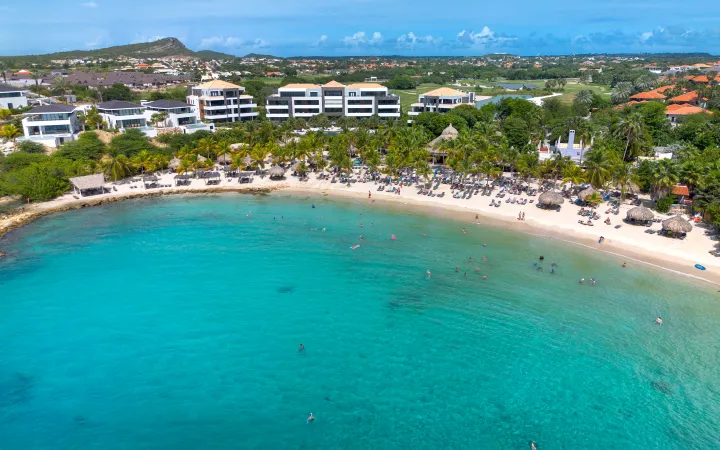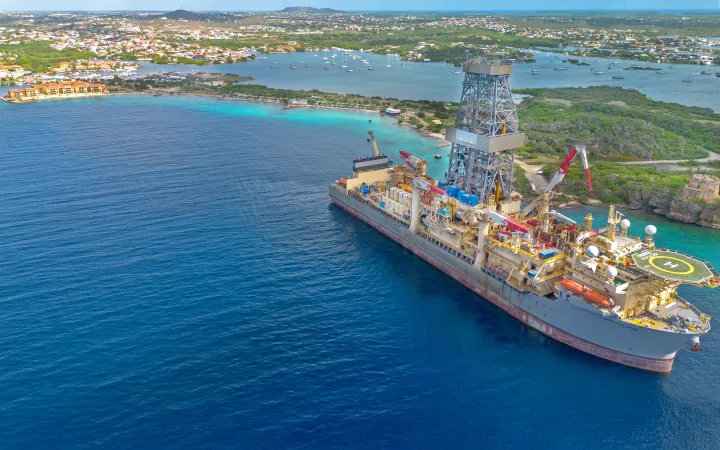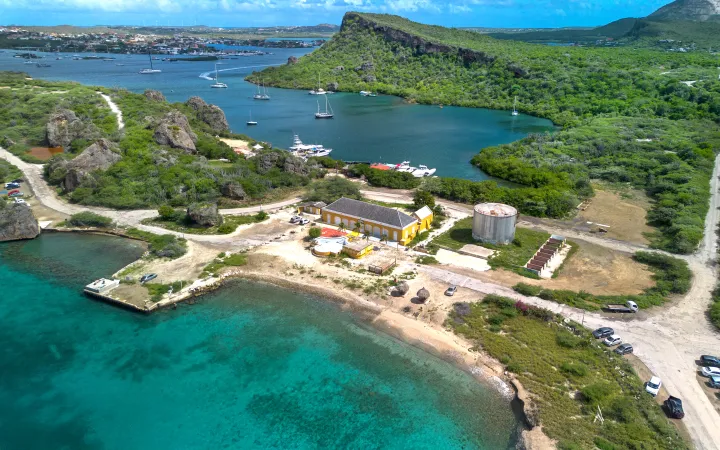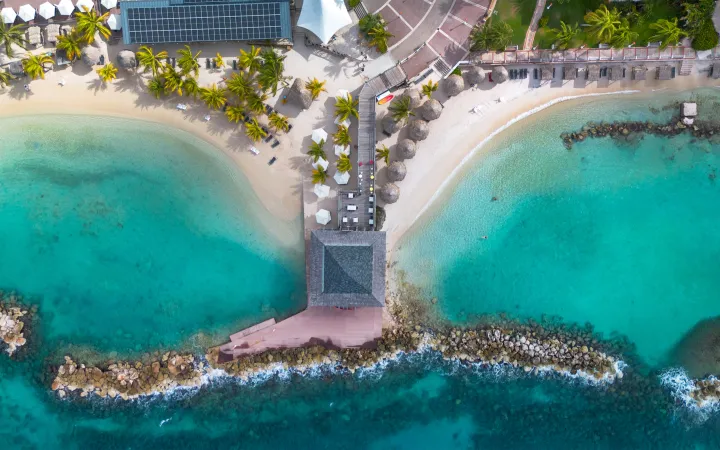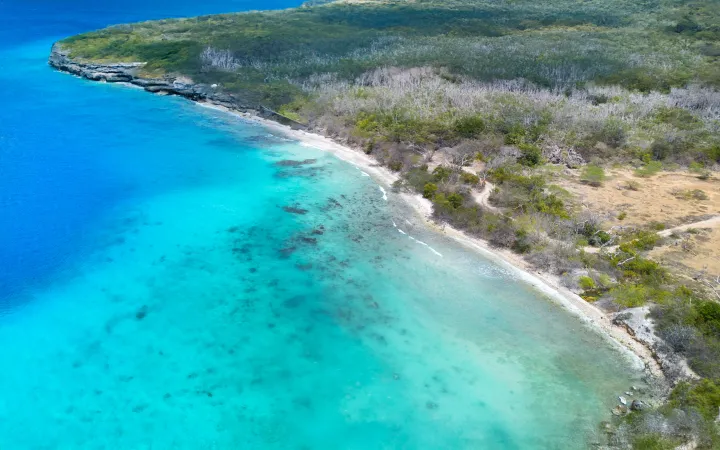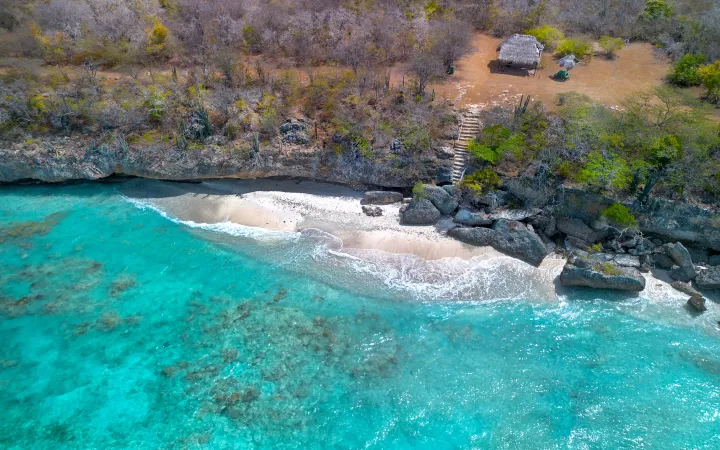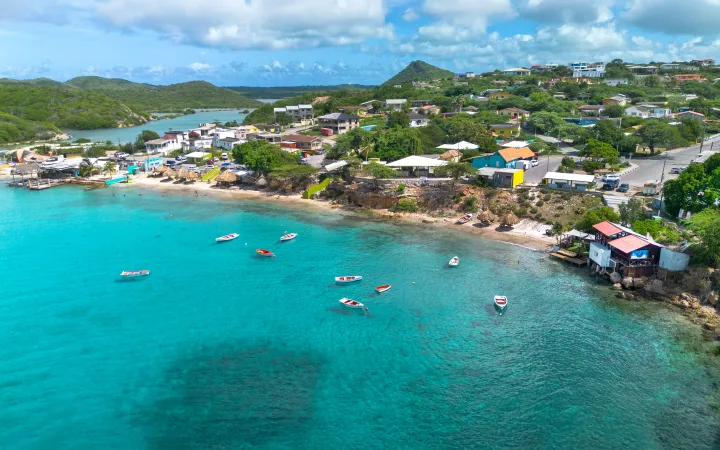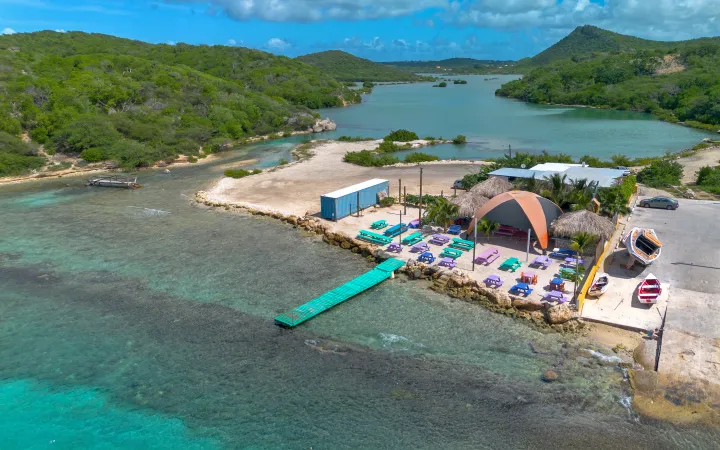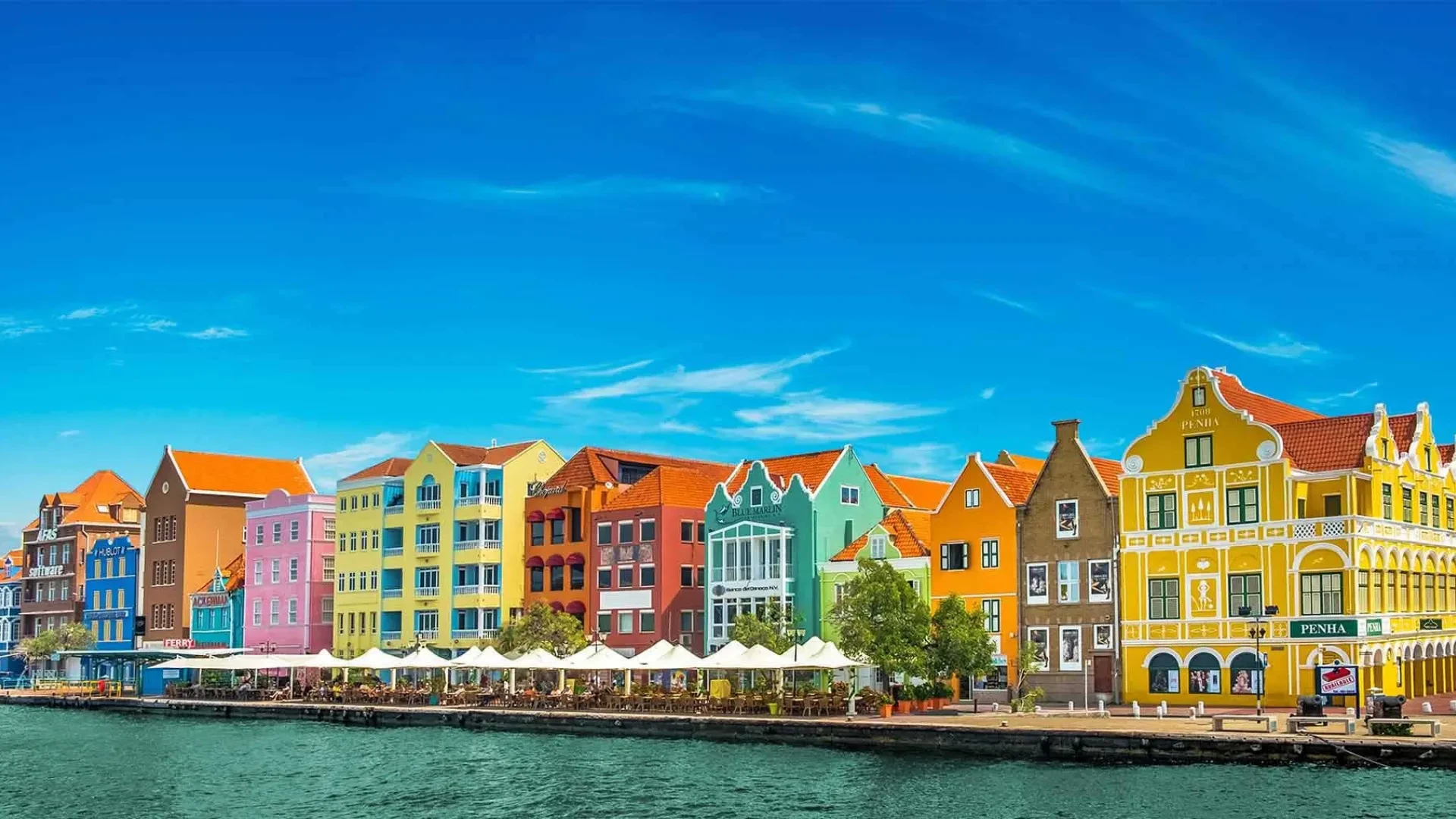
Little Europe in the Caribbean
Best things to do in Curacao: From sightseeing to excursions
Curacao travel blog
Where To Stay In Curaçao: Best Areas, Hotels & Hidden Gems
Curacao Food Guide: 15 Must-Try Caribbean Krioyo Dishes
Where To Stay In Curaçao: Best Areas, Hotels & Hidden Gems
Curacao Food Guide: 15 Must-Try Caribbean Krioyo Dishes
Things to see in Curacao
Rich history, translucent water and diverse landscapes caracterize the delightful Dutch island of Curaçao that is also known as ‘Little Europe of the Caribbean’. The colorful UNESCO heritage capital of Willemstad offers an excellent setting for sightseeing walking tours, while sea enthusiasts may choose one of the beach hopping excursions to the countless glorious beaches of Curaçao. Artsy travelers are in for a real treat as well with the numerous museums and exhibits the island conceals along with colonial buildings and forts from the pirate era. Explore the rugged landscape of the island at Shete Boka National Park and visit well-known attractions like the Supladó Natural Jacuzzi, Boca Wandomi Natural Bridge and Any visit to Curaçao would not be complete without a day trip to Klein Curaçao, the mecca for sun seekers, divers and snorkelers alike.
Beaches
Blue Bay Beach
Blue Bay Beach in Curaçao is one of the island’s most inviting resort beaches, set in a wide protected bay just northwest of Willemstad. With soft golden sand, calm turquoise water, and a lively yet relaxed vibe, it’s the kind of place where you can spend the whole day — swimming, snorkeling the house reef, or grabbing a drink at the beach bar while sailboats drift past offshore.
Caracas Bay Beach
Caracas Bay Beach, Curaçao is a laid-back coastal spot on the island’s southeast side, just past the Jan Thiel area. Known for its calm turquoise waters, local food shacks, and the nearby Fort Beekenburg and Tugboat wreck, it’s one of those beaches that feels both authentic and adventurous.
Baya Beach
Baya Beach Curaçao is a small, rugged cove beside Fort Beekenburg in Caracas Bay, with coarse sand, very few people, and historically no real facilities or shade. The backdrop is industrial: you’re looking across an old Shell bunker port area with an oil drill platform. There is no good reason to visit Baya Beach unless you are heading to the nearby Tugboat Beach.
Avila Beach
Avila Beach Hotel has a calm, swimmable double-lagoon beach in the historic Pietermaai district of Willemstad, the capital of Curacao. It is protected by breakwaters — great for easy snorkeling, SUP, and cruise-day lounging with a day pass.
Boka Spanjo
Boka Spanjo is one of Curaçao’s most remote coves, reached only by hiking or by boat from Playa Santa Cruz. The trail takes about 1 hour one-way, leading to a quiet bay framed by cliffs and clear turquoise water. There’s nothing here but nature — no crowds, no facilities, just pure west-coast wilderness.
Boka Hulu
Boka Hulu in Curaçao is a tiny, secluded cove on the island’s wild west coast, known for clear turquoise water, white sand under limestone overhangs, and zero facilities. Access is by hike from Playa Santa Cruz or by boat/kayak, which keeps it blissfully quiet.
Boka Sami
Boka Sami Beach, also known as St. Michiel Bay, is in a quiet fishing village on the west coast of Curaçao. It’s a spot where colorful boats line the shore, locals gather by the pier, and travelers come for relaxed swimming and snorkeling. Peaceful, authentic, and feels like a glimpse of old island life.
Boka Sint Michiel
Boka Sint Michiel is a quiet coastal bay on the southwest side of Curaçao known for its laid-back local vibe, calm turquoise water, and small fishing pier. It’s a peaceful spot where you can snorkel straight from shore or watch the sunset with a cold drink. Though often confused with nearby Boka Sami, this little cove has its own authentic charm — simple, scenic, and perfectly Curaçaoan.
Curacao good to know before traveling
Holiday in Curacao: Everything you need to know
Curacao, located in the southern Caribbean Sea, is part of the Dutch Caribbean and is renowned for its vibrant culture, beautiful beaches, and colorful colonial architecture. With its European charm mixed with Caribbean flair, Curacao offers a perfect escape for travelers looking for relaxation, adventure, and a taste of local heritage. Known for its UNESCO World Heritage-listed capital, Willemstad, Curacao also boasts stunning coral reefs, making it a haven for divers and snorkelers. Whether you’re wandering through the streets of the historic capital or lounging on a secluded beach, our free Curacao travel guide insights will help you make the most of your trip.
From the iconic Handelskade waterfront, lined with pastel-colored buildings, to the crystal-clear waters of Playa Kenepa, Curacao offers a diverse experience that combines culture, history, and natural beauty. The island is known for its excellent scuba diving, laid-back atmosphere, and unique Dutch-Caribbean fusion cuisine. Whether you're seeking a romantic getaway, a family vacation, or an adventure-filled trip, our Curacao travel guide with insider tips has something for everyone.
Ready to explore Curacao’s vibrant offerings? Continue reading our comprehensive Curacao travel guide for top attractions, hidden gems, and essential tips to plan your perfect Caribbean getaway.
Curacao Tourism Info: Things to Know Before Traveling
Before traveling to Curacao, it’s important to know a few key details to ensure a smooth and enjoyable vacation. Our Curacao travel planner will provide everything you need to know, from practical travel tips to navigating the island’s culture and history.
Essential Curacao Travel Information:
Passport: A valid passport is required for entry. Most visitors from the U.S., Canada, and the EU can stay for up to 90 days without a visa.
Currency: The official currency is the Netherlands Antillean Guilder (ANG), but U.S. dollars are widely accepted. Major credit cards are also commonly used.
Language: Dutch is the official language, but Papiamento, English, and Spanish are also widely spoken throughout the island.
Weather: Curacao enjoys a tropical climate with warm temperatures year-round, averaging between 77°F (25°C) and 88°F (31°C). The island is located outside the hurricane belt, making it a great year-round destination.
Health and Safety: Curacao is a safe destination, but it’s always a good idea to use common sense and keep an eye on personal belongings, especially in crowded areas.
Transportation: Renting a car is the best way to explore the island, though taxis are available. Public transportation is limited, so it’s recommended to have your own mode of travel.
Electricity: Curacao uses 127V and Type A/B plugs, similar to the U.S., though some hotels may use European-style plugs.
Water Quality: Tap water is safe to drink, as it’s distilled from seawater and highly purified.
Local Customs: Curacao has a laid-back island vibe, but it’s important to be respectful, especially in more rural areas. Casual attire is common, but modest dress is appreciated in churches or religious sites.
Time Zone: Atlantic Standard Time (AST), with no daylight saving time.
Tipping: Tipping is common in restaurants, taxis, and for services. A 10-15% tip is customary, especially if a service charge is not already included.
Emergency Numbers: Dial 911 for police, fire, or medical emergencies.
Travel Insurance: It’s recommended to have travel insurance that covers medical emergencies, accidents, and trip cancellations.
For more detailed tips on how to navigate the island, check out our complete Curacao travel guide for first-time visitors, where you’ll find insights on culture, local customs, and fun facts about the island’s unique history.
Top 10 Reasons to Visit Curacao: A Bucketlist Destination
Curacao is a hidden gem in the Caribbean, offering stunning beaches, rich history, and vibrant culture. Here are the top 10 reasons why Curacao should be on your travel bucket list:
1. Colorful Willemstad
The island’s capital, Willemstad, is a UNESCO World Heritage Site known for its brightly colored colonial buildings, vibrant markets, and rich history. The iconic Handelskade waterfront is a must-see.
2. World-Class Diving and Snorkeling
Curacao is famous for its crystal-clear waters and stunning coral reefs. With over 60 dive sites, including the famous Tugboat wreck, Curacao is a top destination for divers and snorkelers.
3. Stunning Beaches
From the popular Playa Kenepa to the more secluded Cas Abao Beach, Curacao offers a wide range of beaches with powdery white sand and turquoise waters perfect for swimming and relaxation.
4. Unique Dutch-Caribbean Culture
Experience a mix of European charm and Caribbean rhythm, reflected in the island’s architecture, cuisine, and vibrant festivals.
5. Flamingo Watching
Curacao is home to several salt flats where you can spot beautiful pink flamingos in their natural habitat. Head to Jan Kok or Sint Willibrordus to see these stunning birds.
6. Rich History
Explore Curacao’s colonial history by visiting landmarks like Fort Amsterdam, the Kura Hulanda Museum, and the Queen Emma Bridge, known as the “Swinging Old Lady.”
7. Outdoor Adventure
Curacao offers plenty of outdoor activities, including hiking Mount Christoffel, the island’s highest peak, and exploring the limestone caves at Hato Caves.
8. Delicious Local Cuisine
Sample Curacao’s fusion of Caribbean and European flavors, with local dishes like keshi yena (stuffed cheese), fresh seafood, and stoba (stew). Be sure to try the island’s famous liqueur, Blue Curacao.
9. Eclectic Nightlife
The island offers a diverse nightlife scene, from beach bars to nightclubs and casinos. Willemstad’s Punda and Otrobanda neighborhoods come alive with live music, dancing, and entertainment.
10. Year-Round Sunshine
Curacao’s sunny, warm weather year-round makes it an ideal destination for sun seekers. With its location outside the hurricane belt, it’s a worry-free option even during hurricane season.
Curacao Travel Planner: Experience the Culture, Visit Famous Landmarks, and Discover Hidden Gems
Curacao is a destination that offers a perfect mix of cultural exploration, outdoor adventure, and serene beach relaxation. Here are some key experiences to include in your Curacao travel itinerary:
Wander Through Historic Willemstad
Curacao’s capital city, Willemstad, is a UNESCO World Heritage Site with a unique blend of Dutch colonial architecture and vibrant Caribbean colors. Among the many Willemstad attractions, the famous Handelskade, with its brightly painted buildings, is one of the most iconic sights in the Caribbean. Take a stroll across the Queen Emma Bridge, known as the “Swinging Old Lady,” and explore the Punda and Otrobanda neighborhoods, where you’ll find charming shops, cafes, and art galleries. Don’t miss the Kura Hulanda Museum, which tells the story of the island’s African heritage and history of slavery.
Relax on Curacao’s Stunning Beaches
Curacao boasts some of the most beautiful beaches in the Caribbean, each with its own unique charm. Playa Kenepa is one of the island’s most famous beaches, known for its crystal-clear waters and breathtaking views. For a more secluded spot, head to Cas Abao Beach, where you can enjoy soft white sand and calm waters perfect for swimming and snorkeling. For a family-friendly option, visit Playa Porto Mari, which has gentle waves, a beach bar, and easy access to excellent snorkeling spots.
Hike Mount Christoffel
For nature lovers and adventurers, a hike to the summit of Mount Christoffel, the highest point on the island, is a must. Located within Christoffel National Park, this moderately challenging hike offers stunning panoramic views of the island and the surrounding sea. The park is also home to a variety of wildlife, including Curacao’s native white-tailed deer, and offers several other hiking trails for different skill levels.
Explore the Hato Caves
The Hato Caves, located near Willemstad, are a fascinating natural attraction that dates back millions of years. Take a guided tour through the limestone caves to discover impressive stalactites, stalagmites, and ancient petroglyphs left by the island’s indigenous people. The caves are also home to a colony of long-nosed fruit bats, adding to the unique experience.
Snorkeling and Diving Adventures
Curacao’s underwater world is just as stunning as its landscapes. For snorkeling, head to Playa Lagun, where the calm, shallow waters are perfect for spotting sea turtles and tropical fish. For divers, the island offers world-renowned dive sites, including the famous Tugboat wreck and the Mushroom Forest, an underwater coral garden shaped like giant mushrooms. Curacao’s clear waters and abundant marine life make it a paradise for water sports enthusiasts.
Visit the Flamingo Sanctuary
Curacao is home to several salt flats where you can see wild flamingos in their natural habitat. Head to the Jan Kok salt flats or the flamingo sanctuary near Sint Willibrordus for a peaceful wildlife experience. The pink flamingos are a beautiful contrast against the island’s bright blue skies and salty marshes, offering great photo opportunities.
Savor Curacao’s Culinary Scene
Curacao’s food is a blend of Caribbean, Dutch, and Latin influences, creating a unique fusion of flavors. For a true taste of the island, visit one of the local truk’i pan food trucks, where you can enjoy grilled meats, sandwiches, and seafood late into the night. In Willemstad, Grand Cafe De Heeren offers a great mix
Curacao Travel Guide: Arrive as a Tourist, Leave as a Local
Curacao is an island that invites you to explore its rich history, diverse culture, and stunning natural beauty. Whether you're wandering the colorful streets of Willemstad, relaxing on secluded beaches, or diving into the vibrant underwater world, planning a trip to Curacao offers unforgettable experiences for every traveler. The island's welcoming atmosphere and unique blend of Caribbean and European influences ensure that you’ll leave with a deeper appreciation of its culture and charm.
With the help of our trusted Curacao travel guide, you’ll not only discover the top attractions but also uncover hidden gems and local experiences that will transform your trip from a vacation into a lifelong memory. Curacao is more than just a destination—it's a place where you arrive as a tourist and leave as a local, forever connected to its beauty and warmth.
